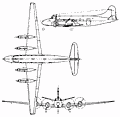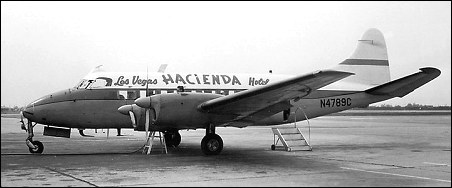|
| Adopting the same philosophy that had
produced the highly successful fourengined
D.H.86B after the D.H.84
Dragon, de Havilland continued the success
of the Dove by designing a
scaled-up version designated de Havilland
D.H.114 Heron. Simplicity and
reliability were the keynotes for the new
aircraft, which provided accommodation
for a crew of two and 14 passengers (17
if no toilet was installed). Fixed tricycle
landing gear eliminated the complications
of a hydraulic system, and excellent
short-field performance was
assured by good wing design coupled
with the use of variable-pitch propellers,
driven by Gipsy Queen 30s which had a
long operating period between overhauls.
The prototype was
flown for the first time on 10 May 1950.
The first production Heron 1 was
acquired by New Zealand National Airways,
this and all subsequent aircraft
having a tailplane with considerable
dihedral. The seventh production
example served as the prototype for the
Heron 2, incorporating retractable landing
gear which gave an increase in speed
and a reduction in fuel consumption.
This proved to be the most popular version,
representing almost 70 per cent of
the 150 Herons built. Despite these relatively
small production figures, the
Heron saw service in 30 countries, some
with major airlines, many as luxury transports
(including four operated by The
Queen's Flight at RAF Benson), and
about 25 of the total were used as communications
aircraft by nine military
services.
In their later years Herons were the
subject of a number of modification programmes,
the Riley Turbo Skyliner
produced by the Riley Turbostream Corporation
in the USA being typical of reengined
aircraft. This replaced the
standard powerplant by 216kW Avco Lycoming IO-540 engines, with or
without turbochargers according to
customer requirements. Far more ambitious
was the conversion carried out by
Saunders Aircraft Corporation of Gimli,
Manitoba. Designated Saunders
ST-27, this had a fuselage lengthened
by 2.59m to provide accommodation
for a maximum of 23 passengers,
the wing rebuilt to incorporate a redesigned
main spar and the four Gipsy
engines replaced by two 559kW Pratt & Whitney Aircraft of Canada
PT6A-34 turboprop engines. A total of 12
ST-27 conversions was completed and
the prototype of an improved ST-28
was built before Saunders went into receivership.
| MODEL | Heron 2D |
| ENGINE | 4 x de Havilland Gipsy Queen 30-2 inline piston engines, 186kW |
| WEIGHTS |
| Take-off weight | 6123 kg | 13499 lb |
| Empty weight | 3697 kg | 8151 lb |
| DIMENSIONS |
| Wingspan | 21.79 m | 72 ft 6 in |
| Length | 14.78 m | 49 ft 6 in |
| Height | 4.75 m | 16 ft 7 in |
| Wing area | 46.36 m2 | 499.01 sq ft |
| PERFORMANCE |
| Cruise speed | 295 km/h | 183 mph |
| Ceiling | 5640 m | 18500 ft |
| Range | 1473 km | 915 miles |
 | A three-view drawing (700 x 684) |
| John Ives, e-mail, 02.09.2010 02:32 I owned and ran the last commercial operation of heron Aircraft in the world. They were used for long haul tourist flights around Australia.
We also probably did the last long haul flight in a piston powered 4 engine propellor aircraft (a Heron) on either of these two flights.
the first was from Staverton (UK) to Sydney (Australia) in 1993. The second was an extend Air cruise through the Pacific from Stydney through to the Cook Islands.
If anyone can be that I would be very surprised.
Currently I am re writing the history of the Heron Aircraft and its operations. My aim is to document including at least one picture of every serial number. reply | | George T Spettigue, e-mail, 03.02.2010 00:15 I have over 6000 hours in the Heron 2 as flown by Puerto Rico International Airlines (PRINAIR) powered by 4 @ Continental IO-520 300 HP powerplants. Our route structure extended from Hispanola in the west down the island chain Guadaloupe, FI, in the east as well as anywhere in the Caribbean on special flights. reply | | william jamieson, e-mail, 30.03.2008 22:55 i thought id just ask, like Ken has. if you could mark the lower picture as a dove. it is misleading if you dont know the aircraft like i do reply | | Ken Watkins, CEng., MRAeS., e-mail, 27.06.2007 16:39 From 1949 to 1953, having graduated from the de Havilland Aeronautical Technical School, I worked in the stress office at Hatfield, mostly on the DH.106 Comet wing, but also for a short time on the Heron wing as it was being enlarged from the Dove wing and redesigned for four engines. The history given above, especially about the substantial modifications made to the Heron in the USA, is new to me and very interesting.
May I suggest that a note be added that the lower photograph shown is of the DH.104 Dove? Also, it would be interesting to know the sources of the information, photographs and drawings displayed for these and other aircraft. reply |
|
Do you have any comments?
|
| 
COMPANY
PROFILE
All the World's Rotorcraft
|








